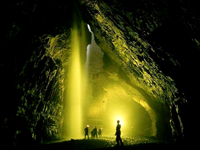Mammoth Cave in Kentucky is the largest cave in the world, with more than 390 miles of passageway and new discoveries adding several miles to this total each year.

Spelunkers compete to explore it, early 1900s farmers competed to sell it, and now the best minds in math and physics compete to explain it. For centuries, researchers have understood the basics: caves form when water trickles through tiny rock fractures. But the question has still remained: how does a small flow of water erode rock fast enough to make 300-mile tunnels? Now, an answer emerges from a series of math equations. This discovery has applications in everything from the safety of dams to the fate of nuclear waste. Read the full article here.